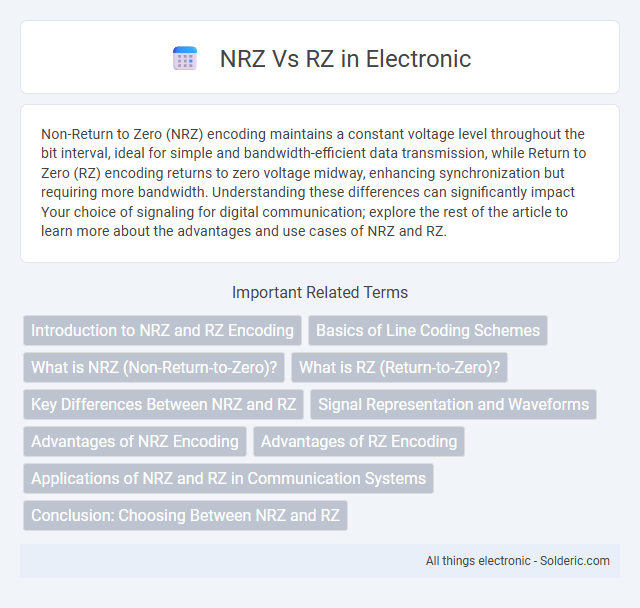Non-Return to Zero (NRZ) encoding maintains a constant voltage level throughout the bit interval, ideal for simple and bandwidth-efficient data transmission, while Return to Zero (RZ) encoding returns to zero voltage midway, enhancing synchronization but requiring more bandwidth. Understanding these differences can significantly impact Your choice of signaling for digital communication; explore the rest of the article to learn more about the advantages and use cases of NRZ and RZ.
Comparison Table
| Feature | NRZ (Non-Return to Zero) | RZ (Return to Zero) |
|---|---|---|
| Signal Level | Constant voltage for entire bit duration | Returns to zero voltage in the middle of the bit period |
| Bandwidth Efficiency | Higher, uses less bandwidth | Lower, requires more bandwidth |
| Synchronization | Poor synchronization, no guaranteed signal transition | Better synchronization due to signal returning to zero |
| Power Consumption | Lower power consumption | Higher power consumption due to more transitions |
| Complexity | Simpler encoder and decoder | More complex encoder and decoder |
| Error Detection | Less robust, harder to detect errors | More robust, easier error detection |
| Typical Usage | Digital data transmission, simple applications | Higher speed optical and digital communication |
Introduction to NRZ and RZ Encoding
NRZ (Non-Return-to-Zero) encoding maintains signal levels without returning to zero between bits, optimizing bandwidth efficiency for data transmission. RZ (Return-to-Zero) encoding, by contrast, includes a transition to zero within each bit period, enhancing synchronization but requiring more bandwidth. Understanding NRZ and RZ encoding helps you choose the ideal modulation method based on transmission speed and channel conditions.
Basics of Line Coding Schemes
Non-Return-to-Zero (NRZ) and Return-to-Zero (RZ) are fundamental line coding schemes used in digital communication to encode binary data into signals. NRZ maintains continuous voltage levels for the entire bit duration, representing '1' and '0' with distinct voltage states without returning to zero between bits, which simplifies bandwidth usage but can cause synchronization challenges. RZ, on the other hand, introduces a return to zero voltage level within each bit period, making it easier to detect bit boundaries and synchronize clocks at the cost of requiring higher bandwidth due to more frequent signal transitions.
What is NRZ (Non-Return-to-Zero)?
NRZ (Non-Return-to-Zero) is a binary signal encoding scheme where the signal level remains constant during the entire bit interval, representing '1' with one voltage level and '0' with another without returning to a zero or baseline voltage between bits. This method reduces the bandwidth required for transmission compared to RZ (Return-to-Zero) encoding, where the signal returns to zero in the middle of each bit. Understanding NRZ is crucial for optimizing your digital communication systems for bandwidth efficiency and signal integrity.
What is RZ (Return-to-Zero)?
Return-to-Zero (RZ) is a digital signaling method where the signal returns to zero voltage between each bit, indicating a clear distinction between individual bits. RZ encoding ensures synchronization by including a return to the baseline within each bit period, reducing timing errors compared to Non-Return-to-Zero (NRZ) formats. You can enhance data integrity in communication systems by choosing RZ when precise timing recovery is essential.
Key Differences Between NRZ and RZ
NRZ (Non-Return-to-Zero) signals maintain a constant voltage level to represent binary data, while RZ (Return-to-Zero) signals return to zero voltage between each bit, providing clear bit separation. NRZ is more bandwidth-efficient since it uses fewer transitions, but RZ offers better synchronization and reduced inter-symbol interference. Understanding these key differences can help you choose the appropriate encoding scheme for reliable digital communication systems.
Signal Representation and Waveforms
NRZ (Non-Return-to-Zero) signal representation maintains a constant voltage level throughout the bit duration, with '1' and '0' represented by two distinct voltage levels, resulting in simpler waveforms with no intermediate transitions. RZ (Return-to-Zero) coding divides each bit interval into two halves, where the signal returns to zero voltage within the bit period, creating a pulse for '1' and zero voltage for '0', producing more frequent transitions and distinct pulses. Waveforms of NRZ signals are more bandwidth-efficient due to fewer transitions, while RZ waveforms improve synchronization by providing clear timing references at the cost of higher bandwidth usage.
Advantages of NRZ Encoding
NRZ encoding offers the advantage of simplicity in implementation, requiring fewer transitions which reduces bandwidth usage and power consumption. Its efficiency makes NRZ suitable for long-distance communication systems where minimizing signal distortion is crucial. Choosing NRZ encoding can enhance your data transmission reliability by maintaining clear distinction between binary states over time.
Advantages of RZ Encoding
RZ encoding offers improved synchronization by including a return-to-zero voltage level, which helps maintain signal timing accuracy and reduces intersymbol interference. It provides better error detection capabilities due to distinct signal transitions within each bit period. RZ encoding also enhances signal integrity over long distances in optical communications by minimizing baseline wander and DC component issues compared to NRZ.
Applications of NRZ and RZ in Communication Systems
NRZ (Non-Return-to-Zero) encoding is widely used in digital communication systems such as Ethernet and USB due to its bandwidth efficiency and simplicity, making it ideal for long-distance data transmission. RZ (Return-to-Zero) encoding finds applications in optical fiber communication and high-speed serial links where synchronization and error detection are critical because the signal returns to zero within each bit interval. Communication protocols like SONET and Synchronous Digital Hierarchy (SDH) often employ RZ to maintain timing integrity and reduce intersymbol interference.
Conclusion: Choosing Between NRZ and RZ
Choosing between NRZ (Non-Return-to-Zero) and RZ (Return-to-Zero) depends on factors such as power efficiency, bandwidth requirements, and error tolerance. NRZ offers higher bandwidth efficiency and simpler implementation, making it suitable for long-distance communication, while RZ provides better synchronization and reduced intersymbol interference, ideal for systems needing higher timing accuracy. Your decision should align with the specific application demands, balancing data integrity and transmission efficiency.
NRZ vs RZ Infographic

 solderic.com
solderic.com